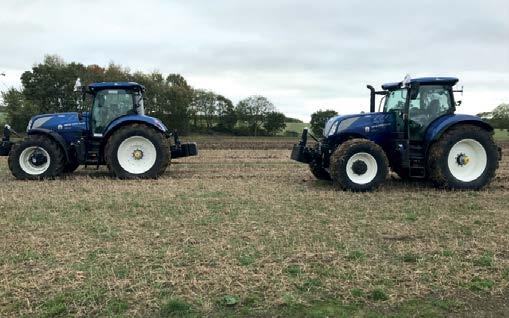HISTORY OF THE GD Written by Tony Gent
With over 60 years of farming, I have seen and been involved with so many changes, as a lad from working with horses and leaving school at 15 to working on my father’s smallholding with only 50 acres and a mix of cropping. The farm began to mechanise and expand, so did my interest in designing better tools, particularly to improve soil management. The need to produce crops in an economic and competitive way has always been my driving force, with the sustainability of the business as well as ecology and the environment. We first started to notice the importance of soil condition in the 1960s, with taking on heavy distressed soil which was suffering from poor cultivation techniques, resulting in pans and compacted layers. Having mastered those problems it became obvious that moving soil around was not only complex and expensive, but the soil workability was deteriorating and more liable to slump, cap and puddle. At that time larger more complex machinery was becoming available and seen as a major part of the solution. To take advantage of larger tractors, particularly tracklayers with threepoint linkage and larger 4-wheel drive in the 70s my first development was what became known as the “Wilder Pressure Harrow”, my own design of harrow which was manufactured and marketed by John Wilder Engineering. This consisted of ground following individual units mounted on a parallel linkage, pressurised by a floating
Pressure Harrow
10 DIRECT DRILLER MAGAZINE
hydraulic down force and tines that could be infinitely adjusted. This allowed the scrubbing frame to achieve a precise seed bed for both spring use, on overwintering ploughing and on heavy tined cultivation in the autumn. The Pressure Harrow was awarded a silver Medal at the Royal Agricultural show in 1977 for machinery innervation. With much more emphasis on autumn crops, especially oilseed rape and September establishment of wheat, the Pressure Harrow became invaluable for scratch tillage that was widely adopted. However, to fight soils that were in a poor structural state causing rooting and drainage problems a means of lifting and shattering the soil with minimal surface disturbance was needed. Together with Ken Taylor a local agricultural engineer a low disturbance subsurface tine was developed. This featured a slender point and front shin together with large wings to shatter the soil with a wide lateral effect, allowing wide tine spacing. It achieved the effect of loosening all the soil with no layer mixing or bringing unwanted soil to the surface. It became known as the “Flat Lift” Demand for this method of low disturbance soil loosening coincided with larger horsepower, mostly American, tractors becoming available and to meet the demand for the Flat Lift an engineering company was founded to manufacture and to market it, an agreement with Parker Farm equipment was put place with the product being known as “Parker Farm Flat lift” manufactured by Taylor-Gent Engineering. However, as others adopted this approach competition from more established companies became intense, and as a small specialist manufacturer it was not viable. The rights to the product were acquired by Spalding’s, who still market it as the original “Flat Lift” There was no-doubt we were on the right lines with all this. However, the whole process had to change as
Flat Lift
attitudes to straw-burning changed in the early 90s. We had become experts at this, using combines fitted with spreaders to achieve a 100% burn, completely obliterating trash with no chemical help such as glyphosate. However, as autumn cropping became more common, the intensity of the burn inevitably led to straw-burning being banned, and it almost seems incredible now this practice lasted so long. Although we now realise what we thought was an idyllic situation, but with the first signs of chemical resistance creeping in especially with black grass and brooms we now realise this was an unsustainable situation. The straw burning ban was a massive game changer, as we were growing lots of second and third wheats that were early drilled, producing high volumes of straw to deal with. We had to revert to moving soil around with some inversion or mixing to bury or at least incorporate the straw to some degree. This caused a massive reinvestment in machinery and power to rapidly recover aggressively moved soil into a suitable seedbed in a very short time. During this period, we took advantage of land becoming available with rapid expansion in acreage. Much of this was again soil in a distressed state requiring lots of TLC. Also, with the new FBT and contract farming arrangements with strong competition the rents tendered subsequently proved to be far too high. We had no choice but to invest in lots of power and big soil moving and drilling kit. Due to our limited cash resources and ISSUE 16 | JANUARY 2022























